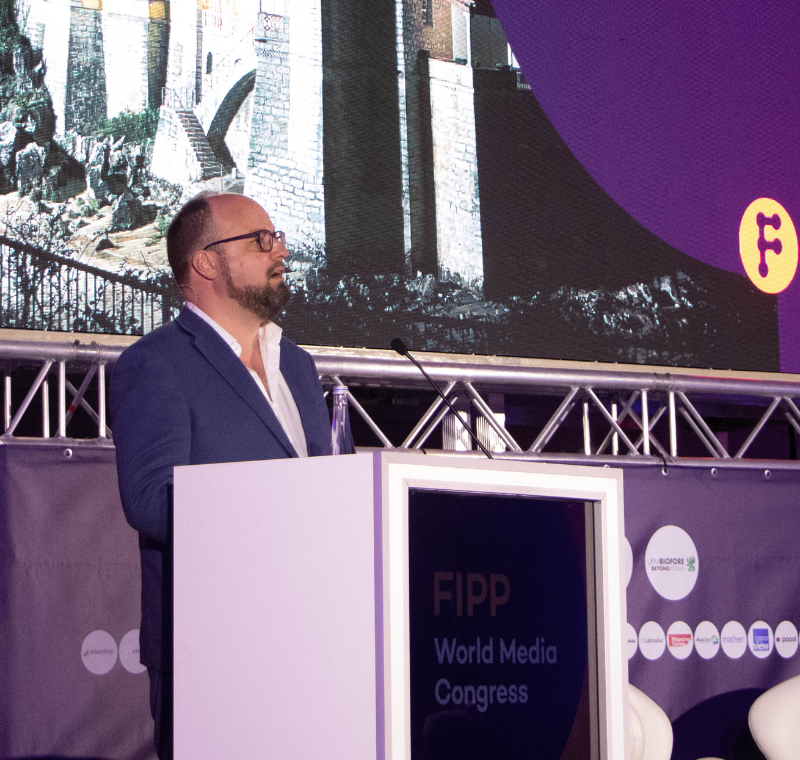‘Get comfortable with being uncomfortable’ – a Q&A with d.school’s Justin Ferrell
He will be one of several speakers at this year’s Digital Innovators’ Summit in Berlin (DIS) on 23-24 March 2015 (that’s only two weeks away, so book your ticket today – or risk losing out).
His work at the d.school, along with his background in news and journalism, makes him an ideal candidate to talk about bringing innovation to media organisations, writes eMedia SF’s (FIPP’s and VDZ’s DIS partner) Beate Borstelmann.
She asked Justin five questions about the value of multi-disciplinary approaches and some of the other principles of innovations that the d.school conveys.
You spent a number of years at the Washington Post. How was your job in news similar to your current job at the d.school?
I think they’re very similar. When I became the first digital design director at The Post, I viewed my job as finding highly skilled designers and programmers who wanted most to make a difference in the world, hiring them, and enabling them to do our best work. That meant facilitating multidisciplinary project and platform teams that embedded our specialists with reporters and editors, data visualization folks, video journalists, photographers, etc. These diverse teams created amazing projects together that they wouldn’t have come up with if they’d worked in silos in a handoff, assembly-line way.
At the d.school, this multidisciplinary collaboration is systematised. We’re the only place at Stanford where graduate students from all seven schools – engineering, business, medicine, law, education, earth/science and the humanities – come together to work on projects. They’re domain experts, and we help them apply their expertise by mashing up their skills and viewpoints to create unique solutions. So the process, and the enabling of individuals and teams to work in this way, is very similar. And it’s a way of working that’s important now because of our agency to connect and collaborate through technology.
Tell me about the d.school at Stanford and what it is trying to achieve.
We have a saying at the d.school, “you are the there there here,” which means that each individual has their own experience and responsibility in our collective work to help others. So the best way to understand it without experiencing it for yourself — which we highly recommend! — is in this description from our website:
The d.school is a hub for innovators at Stanford. Students and faculty in engineering, medicine, business, law, the humanities, sciences, and education find their way here to take on the world’s messy problems together. Human values are at the heart of our collaborative approach. We focus on creating spectacularly transformative learning experiences. Along the way, our students develop a process for producing creative solutions to even the most complex challenges they tackle. This is the core of what we do.
In a time when there is hunger for innovation everywhere, we think our primary responsibility is to help prepare a generation of students to rise with the challenges of our times. We define what it means to be a d.school student broadly, and we support “students” of design thinking who range from kindergarteners to senior executives. Our deliberate mash-up of industry, academia and the big world beyond campus is a key to our continuing evolution.
Give me a brief overview of what design thinking is.
Design thinking, to me, is a process that helps multidisciplinary teams focus on the people they’re trying to serve, which I believe is the best way to create meaningful solutions for others and to bring your whole self to your work.
What is creative confidence and why is it important?
You can’t expect to be innovative if you don’t change the way you work. If you just stay the same, you can rationally expect the same outcomes you’re already achieving.
So if you want to create something innovative, you have to do it differently, and that means taking risks. Creative confidence is about helping people realise they can do that. I like to call it “getting comfortable being uncomfortable.”
What are the keys to fostering innovation in an organisation?
Focus on enabling innovators before making innovations – you’ll actually end up with more innovations that way.
Don’t miss
The Digital Innovators’ Summit in Berlin (DIS), Germany from 21-24 March 2015, where we will also launch the 2015 edition of the FIPP Innovation World Report.
Alan South’s, innovations practitioner and lecturer at FIPP and Saïd Business School’s (Oxford University) Executive Programme for Innovation and Change, innovation deep-dive session at the DIS. See a Q&A with Alan here.









